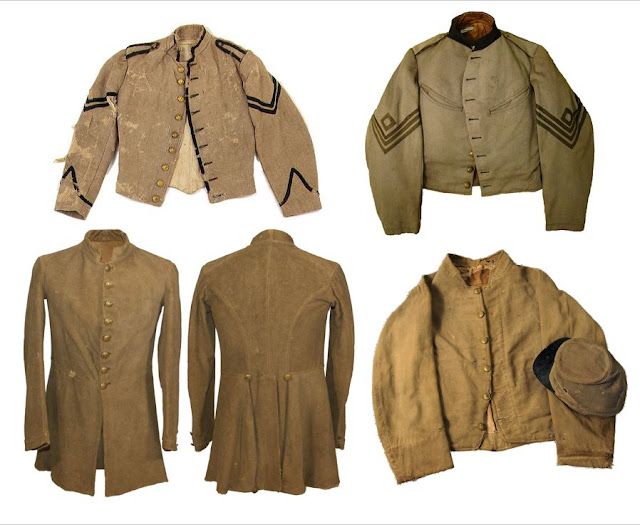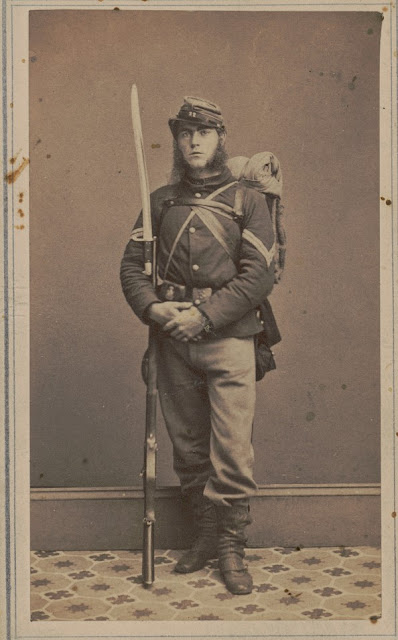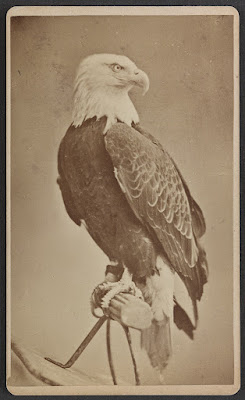Bones in the Brackets: A Graphic Account of the Battle of Mobile Bay
Disabled by a shot that blew her starboard boiler, the U.S. steamer Oneida drifted helplessly in Mobile Bay as the Rebel ironclad Tennessee slowly steamed around her stern then let loose with a devastating broadside.
“Three men were killed in my division and six wounded, but I
escaped unscathed although covered with a shower of splinters and the brains of
my unfortunate Marine bespattered my face,” Lieutenant Edward N, Kellogg wrote
to his father. “Three of our men had their heads shot off and the pieces of
skull bones flying around actually wounded seven or eight men. The shell that
took off the captain’s arm took off the head of a Marine at my 11-inch gun and
wounded both captains of the gun as well as the first loader, besides slightly
wounded several others by scattering around fragments of bones which are now
buried so deep in the brackets as makes it impossible to get them out but by
cutting the wood.”
Lieutenant Kellogg’s letter, written two days after the Battle of Mobile Bay to his father, first saw publication in the September 3, 1864, edition of the Waukegan Weekly Gazette.
 |
| A total of seven sailors and one marine aboard the Oneida were awarded the Medal of Honor for their heroism at Mobile Bay. "All of our men behaved nobly," Lieutenant Kellogg stated. |
U.S. Steamer
Oneida, Mobile Bay, Alabama
August 7, 1864
Dear father,
The bloody fight is over and
additional luster has been added to the old flag. Our colors were hauled down
at sunset on the 5th crowned with victory and glory while many a
mangled body told too well the trying ordeal through which they had passed. On
the evening of the 4th, it was announced that the attack would be
made in the morning at 3:30 on the 5th. The vessels with their
consorts were lashed together and at 5 we headed up the channel, the Oneida
with the Galena lashed to our port side bringing up the rear.
The line was about three miles long
with the Brooklyn leading the van. The Hartford and consort came
second, Richmond came third, Lackawanna came fourth, Monongahela
came fifth, Ossipee came sixth, and Oneida seventh. About 6:30,
Fort Morgan opened fire and was immediately answered by the Brooklyn and
Hartford and the action soon became general. The ironclads Tecumseh, Manhattan,
Chickasaw, and Winnebago formed the inside line abreast of the
leading ships. At 7:05, the Oneida opened fire with her forward rifled
inch pivots with 15- and 10-inch shells. The orders were that as each ship got
abreast of the fort, they must stop their engines and drift with the floodtide
to prevent fouling their propellers.
As we neared the fort, we fired with
shorter fuses and opened with the broadside guns as soon as they could be made
to bear. While abreast of the fort we fired 2-1/2-inch shrapnel while the enemy
answered us with the same kind of projectile. We received our first shot, or
rather first shell, through the cabin at the waterline which killed the captain’s
steward and made a complete wreck of the furniture and bulkheads and not
leaving a piece of board as large as a shingle.
The Rebel ram Tennessee now bore down on us just as a
shell from the fort exploded in our starboard boiler and completely disabled
us, scalding all our firemen and engineers horribly. A temporary panic now
ensued as the men from below rushed on deck with their arms and faces scalded
in a frightful manner. The steam followed them and drove the men from the guns,
leaving us helpless. But the Galena was uninjured and towed us slowly
along. As the steam somewhat cooled the men again rallied and as the Tennessee
approached, they gave a loud shout of defiance and poured a hot fire into
the ugly-looking Rebel.
Our 11-inch solid shot glanced harmlessly from her mailed
sides and she moved silently along. But why don’t she fire, was the question in
everyone’s mouth. Other guns were sending their shot and shell crashing through
us but still she moved mysteriously along. The fact was she had seen the
explosion of our boiler and came down to sink us, but it seemed as though
Providence had interfered for her primers all snapped. She soon rounded to
under our stern and now her guns exploded. We lay completely at her mercy while
her 130-pound shells went raking and crashing through us, mangling and wounding
our men while they had no chance to return her fire.
The carnage here was awful. Shortly after the explosion, our
brave and gallant captain J.R. Madison Mullaney had his arm shot off and was carried below.
The command now devolved on the executive officer Lieutenant Huntington from
Springfield, Illinois and nobly did he emulate the example of our brave
captain. Our men cheered lustily in spite of the officers who, feeling for the
wounded on deck and below, tried to check them.
 |
| The Monongahela was the first of four Federal vessels that rammed the Tennessee. |
The Tennessee, having got about half a mile astern of
us, again turned, this time bent upon sinking us, but the monitors had been
watching her and bore down to our assistance. The admiral not knowing we were
disabled, signaled us and several other vessels to run the Tennessee down
at full speed, although we had signaled that our captain was wounded and the
ship disabled. We could do nothing of course but the Itasca came to
assist in towing us out of range.
We now intently watched those noble ships as they rushed towards
their adversary with a full head of steam. The Monongahela bore down upon
the Tennessee at the rate of 10 knots, but striking obliquely, she
slipped and shot past. The Lackawanna now came boiling along and struck
her fair, which hulled her over slightly, but she, too, slipped and for a
minute the two vessels lay side by side in contact, pouring their deadly fire
into each other. Next came the Hartford who discharged all her shells as she
was advancing and loaded with solid shot. She, too, struck the infernal machine
only to glance off from her slippery side. The monitors in the meantime had
been pouring their 11- and 15-inch shot into her which had carried away her
steering apparatus and knocked her smokestack overboard.
A loud cheer went up from the anxious fleet as the volumes of
black smoke poured from the hole where her smokestack had stood. With her new
wheel ropes rigged, she turned and ran for Fort Gaines, but our vessels were in
hot pursuit and pressed her closely. The Ossipee, which had got ahead of
the others, now made a rush to strike her when she perceived a white flag
flying from the top of the Rebel. Her engines were immediately reversed, but
too late to prevent her striking the ram a heavy blow. A boat was sent on board
and the traitor Admiral Buchanan who was lying wounded below surrendered his
sword to the fleet.
 |
| Sinking of the U.S.S. Tecumseh |
Cheer after cheer rang from the throats of our gallant tars
and the fight was over. But while this fight was going on, another scene was being
enacted in another quarter where our attention had not been attracted. Captain [James Edward] Jouett of the Metacomet, seeing the Rebel gunboat Selma making
tracks for Mobile, immediately gave chase and a short but decisive fight ended
in the surrender of the Rebel gunboat. The remaining cowardly gunboats took
shelter under the guns of Fort Morgan.
I have not forgotten one of the most lamentable and painful events that occurred, but as we did not hear of it until the fight was all over, it will do to bring it in here. Captain F.A. Gwin of the monitor Tecumseh having stood nobly up to his work, ran within 50 yards of Fort Morgan and was sunk almost immediately by the explosion of a torpedo under his ship’s bottom. All hands but the pilot and about 15 men were lost. Most of the escaped party landed at Fort Morgan but the pilot, who had deserted from the Rebels about two months before, swam for dear life with five or six others of the crew and were picked up by a boat and taken in tow by this ship where they all rendered what assistance they could during the fight. Here we now lay, victors in Mobile Bay. Fort Powell, which was so furiously bombarded by the bomb vessels, was evacuated and blown up. Grant’s Pass is now open and yesterday a tinclad came through and brought our mail. [Please see my recent post "Knocking Fort Powell into Pie: In Mobile Bay with the U.S.S. John P. Jackson."]
 |
| Admiral Franklin Buchanan C.S.N. |
After the fight, Admiral Buchanan sent a note to the
commander of Fort Morgan asking permission for one of our vessels to go out
under a flag of truce and carry him and the wounded of both sides to Pensacola.
The request was granted and the Metacomet went next day and came back
this morning. The Rebel commander at Fort Morgan said they might go but had the
impudence to say also that she must return as we were all prisoners in here.
Fort Gaines sent a flag of truce this morning and reports say the fort will
surrender tomorrow to the fleet. Our army is in her rear and has cut off all
communication. As soon as Gaines surrenders, another and a deeper channel will
be opened and supplies without limit can be brought in. Fort Morgan must fall
sooner or later and the city will soon follow suit.
Yesterday, the admiral published a complimentary order
thanking the officers and men of the fleet for so gallantly assisting him and
carrying out his orders and today another order was published requesting all
commanders and crews to join him in offering thanks to Almighty God for the
signal victory achieved through His power. The prisoners are distributed throughout
the fleet. We have 18 men from the Tennessee and Selma. I met two
men from the Tennessee who were my old schoolmates at Annapolis. They
said the admiral and the Rebel crews were surprised to see our wooden ships
attack them as they believed themselves invulnerable.
I must speak of our loss. Seven were killed and one knocked overboard and lost; we lost 38 in killed and wounded. The Hartford lost 25 killed and 52 wounded. Our loss in proportion to numbers is greater than theirs. Three of our men had their heads shot off and the pieces of skull bones flying around actually wounded seven or eight men. The shell that took off the captain’s arm took off the head of a Marine at my 11-inch gun and wounded both captains of the gun as well as the first loader, besides slightly wounded several others by scattering around fragments of bones which are now buried so deep in the brackets as makes it impossible to get them out but by cutting the wood. The same shot disabled the gun. An 8-inch shot disabled an 8-inch gun in my division and killed the first captain and first sponger. One of our powder boys had his passing box knocked overboard and jumped over after it and brought it back on board. All our men behaved admirably.
Rousing cheers are again given this morning as the Rebel flag on Fort Gaines is hauled down and the American flag is run up in its place. A salute from the fort was fired in honor of the event. Three men were killed in my division and six wounded, but I escaped unscathed although covered with a shower of splinters and the brains of my unfortunate Marine bespattered my face. The Rebels say they were thunderstruck to see so many ships pass the forts as 300 torpedoes had been buoyed in the channel through which we had passed, but the strong current must have swept them away. This ship is severely impaired and will require 4 months of repairs before she will be fit for duty again. We cannot get out of here until Fort Morgan surrenders.
Affectionately
your soon,
Edward N. Kellogg
For another account of Mobile Bay written by Lieutenant Kellogg's shipmate Ensign Charles Vernon Gridley, please check out "Damning the Torpedoes in Mobile Bay."
Source:
Letter from
Lieutenant Edward Nealley Kellogg, U.S.S. Oneida, Waukegan Weekly
Gazette (Illinois), September 3, 1864, pg. 2










Comments
Post a Comment